- Home
- Barbara Ehrenreich
Dancing in the Streets: A History of Collective Joy Page 2
Dancing in the Streets: A History of Collective Joy Read online
Page 2
Science Confronts the Ecstatic
With the rise of the social sciences, and especially the anthropology of the 1930s and thereafter, Westerners began to view the ecstatic practices of non-Westerners in an ostensibly more open-minded way. Words like savage and primitive dropped from the ethnographic vocabulary, along with the notion that the people who had once borne these labels represented a biologically less evolved form of Homo sapiens. Medical science could find no differences in the brains of the former primitives to account for their different behavior; colonialists necessarily observed that yesterday’s “savage” might be today’s shopkeeper, soldier, or servant. As humanity began to look more like a family of potential equals, Westerners had to concede that the ecstatic behavior found in traditional cultures was not the hallmark of savage “otherness” but the expression of a capacity that may exist, for better or for worse, in all of us.
By the 1930s, anthropologists had begun to think of the rituals of small-scale societies as functional, meaning in some sense rational. Humans are social animals, and rituals, ecstatic or otherwise, could be an expression of this sociality, a way of renewing the bonds that held a community together. In the functionalist anthropology that reached full bloom in the 1940s and ’50s, many of the formerly bizarre-seeming activities of native peoples were explained in this way: as mechanisms for achieving cohesiveness and generating feelings of unity. Americans tried to achieve the same thing through patriotic and religious rituals; the “natives” simply had a different approach.
But right up to our own time, even the most scientific and sympathetic observers have tended to view the ecstatic rituals of non-Western cultures with deep misgivings, when they choose to view them at all. A certain distaste for the proceedings infects the anthropologist Vincent Crapanzano’s 1973 description of ecstatic rites conducted by the Hamadsha brotherhoods of Morocco. “The drumming, by this time, was beginning to have a dulling effect on me,” he reported, “and the music of the ghita an irritating one … The smell of all the hot, close, sweating bodies was stifling.”31
Or consider a curious silence in the anthropologist Victor Turner’s famous study of “the ritual process.” Perhaps more than any other anthropologist of the mid-twentieth century, he recognized collective ecstasy as a universal capacity and saw it as an expression of what he called communitas, meaning, roughly, the spontaneous love and solidarity that can arise within a community of equals. In The Ritual Process, Turner admitted to an initial “prejudice against ritual” and tendency to discount “the thudding of ritual drums.”32 Setting out to correct this oversight, he launched a detailed study of the Isoma cult ritual of the Ndembu people, which he introduces to the reader as consisting of three parts. The first two parts, which involve the manipulation of symbolic objects, are described in great detail and subjected to a thorough structuralist analysis. But the third and final phase, the Ku-tumbuka, or “festive dance,” which one might imagine was the climax of the entire business, is never mentioned again. Apparently Turner decided to skip that part.b
Turner’s theories have been widely credited with giving ecstatic—as well as merely spontaneous and unruly—group behavior a legitimate place in anthropology. In fact, it was a marginal and second-rate place he offered it. To Turner, the central thing about a culture was its structure, meaning, essentially, its hierarchies and rules. The function of ecstatic ritual, he proposed, was to keep the structure from becoming overly rigid and unstable by providing occasional relief in the form of collective excitement and festivity. But only very occasional relief. The thrills of communitas had to be “liminal,” or marginal, in Turner’s scheme; otherwise social breakdown might ensue, “speedily followed by despotism.”33 Hence his irritation with the hippies of his own mid-1960s American culture, who, in his description, employed “‘mind-expanding’ drugs, ‘rock’ music, and flashing lights … to establish a ‘total’ communion with one another,” and who imagined that “the ecstasy of spontaneous communitas” could be prolonged into a routine condition.34 This “Edenic fantasy” seemed utterly irresponsible to Turner, who—apparently not noticing that many of these hippies were involved in subsistence agriculture and other productive ventures—reminded his reader that we do have to worry about “the supplying of humble needs, such as food, drink, clothing.” Echoing the conventional Western cultural bias toward individualism, he added that it’s a good idea to keep a certain “mystery of mutual distance” between individuals.35
Other anthropologists turned to psychology to explain the extravagant rituals of non-Western peoples. Where European and American travelers had once seen savagery, they now saw mental illness, perhaps even nutritional in origin; Crapanzano wondered whether the Hamadsha ecstatics might be suffering from a calcium deficiency.36 The most frequent diagnosis was hysteria, a term invented to describe the neurotic symptoms of upper-middle-class Viennese women near the turn of the century, but now blithely applied to Haitian villagers, Sri Lankan peasants, and anyone else whose behavior defied rational analysis. Alfred Métraux, the renowned ethnographer of the ecstatic Haitian tradition of Vodou, or voodoo, thought that “the symptoms of the opening phase of trance are clearly psychopathological. They conform exactly, in their main features, to the stock clinical description of hysteria.”37 And in a 1981 book on female ecstatics in Sri Lanka, another anthropologist judged that “many of these women are, in a purely clinical sense, hysterical.”38
In very basic ways, psychology was ill-prepared to shoulder the burden anthropologists tried to throw its way. The new science aimed at a universal theory of human emotion and personality, but its theories were derived entirely from studies of the various compulsions, phobias, tics, and “neuraesthenias” afflicting affluent, urban Westerners—disorders that seemed to have no counterpart among “primitives” in their native lands.39 Not only was the science of psychology narrowly culture-bound; its emphasis on pathology largely precluded any careful study of the more pleasurable emotions, including the kind of joy—growing into ecstasy—that was the hallmark of so many “native” rituals and celebrations. In the psychological language of needs and drives, people do not freely and affirmatively search for pleasure; rather, they are “driven” by cravings that resemble pain. To this day, and no doubt for good reasons, suffering remains the almost exclusive preoccupation of professional psychology. Journals in the field have published forty-five thousand articles in the last thirty years on depression, but only four hundred on joy.40
There was one form of pleasure that deeply interested psychologists, from Sigmund Freud on, and that was sexual pleasure. If the festivities and ecstatic rituals of “primitives” had routinely culminated in sexual acts, either public or private, psychology might have been more comfortable with them. The music, the excitement, the close-packed bodies could then all be understood as aphrodisiacs, allowing people to throw off their normal restraints. This is in fact how many Westerners chose to interpret the rituals they observed anyway—as indecent, wanton, and surely sexual in aim.
Some ecstatic rituals did indeed include sexual acts—most commonly pantomimed—or at least ended with couples drifting off together in the night. The Australian corroborree, for example, sometimes featured sexual intercourse of a deliberately “incestuous” kind; that is, involving men and women of the same tribal subunit, which is normally taboo. But even in that case, sex was only part of the proceedings, and by no means the grand climax, so to speak. More commonly, ecstatic rituals were rather chaste undertakings, involving women and men of all ages, following careful scripts, and serving a function that is perhaps best described as “religious.” The self-loss that participants sought in ecstatic ritual was not through physical merger with another person but through a kind of spiritual merger with the group.
Sexual ecstasy usually arises among dyads, or groups of two, but the ritual ecstasy of “primitives” emerged within groups generally composed of thirty or more participants. Thanks to psychology and the psychological concerns of We
stern culture generally, we have a rich language for describing the emotions drawing one person to another—from the most fleeting sexual attraction, to ego-dissolving love, all the way to the destructive force of obsession. What we lack is any way of describing and understanding the “love” that may exist among dozens of people at a time; and it is this kind of love that is expressed in ecstatic ritual. Durkheim’s notion of collective effervescence and Turner’s idea of communitas each reach, in their own ways, toward some conception of love that serves to knit people together in groups larger than two. But if homosexual attraction is the love “that dares not speak its name,” the love that binds people to the collective has no name at all to speak. Communitas and collective effervescence describe aspects or moments of communal excitement; there is no word for the love—or force or need—that leads individuals to seek ecstatic merger with the group.
Freud, the patriarch of Western psychology, was unprepared or unwilling to shed any light on the subject. It is doubtful that he ever witnessed, much less experienced, anything in the way of collective ecstasy. He was aware of the European tradition of carnival, for example, but saw it through the usual prejudices of his class. In a letter to his fiancée, Martha Bernays, he agreed with her that the behavior of the lower-class revelers at the town fair in Wandsbeck was “neither pleasant nor edifying,” especially when compared to the more acceptable and bourgeois pleasures of “an hour’s chat nestling close to one’s love” or “the reading of a book.”41 In his theoretical work too, he could see nothing very edifying about the emotions linking people in groups or, as he put it, crowds. As the anthropologist Charles Lindholm writes, Freud was much taken with the “expansive and intoxicating self-loss” accompanying the love between two individuals, while “in his discourse on the group the emphasis remains on guilt, anxiety and repressed aggression.”42 What people found in the crowd, Freud opined, was a chance to submit to a leader playing the Oedipal role of “primal father”—a “witch doctor,” presumably, or demagogue.
In Freud’s scheme of human affinities, there was only one kind of love: the dyadic, erotic love of one individual for another. This is the problem he set forth in Civilization and Its Discontents: “The antithesis between civilization and sexuality [derives] from the circumstance that sexual love is a relationship between individuals in which a third can only be superfluous or disturbing, whereas civilization is founded on relations between a considerable number of individuals.”43 Unfortunately for civilization, Freud could not imagine a kind of love binding such larger groups of persons. Eros, he said, could unite people two by two, but “he is not willing to go further.” Hence the excitement of groups could only be derivative of the individuals’ dyadic love for the group leader; never mind that ecstatic groups, of the kind observed in “primitive” ritual, often had no leader or central figure at all.
But Western psychology was disabled from comprehending the phenomenon of collective ecstasy in a more philosophically profound way as well. Psychology, almost by definition, focuses on the individual self; its therapies are aimed at bolstering that self against the force of irrational or repressed emotion. But the self is itself a parochial concept, far more meaningful in early-twentieth-century Cambridge or Vienna than in the distant outposts of nineteenth-century European colonialism. As Luh Ketut Suryani and Gordon Jensen, ethnographers of Balinese ecstatic ritual, observe: “The sense of being in control of one’s self is prominent and highly valued in Western personality and thought. This trait is not characteristic of the Balinese, whose lives have in the main been controlled by their families, their ancestors, and the supernatural.”44
To the “self”-admiring Western mind, any form of self-loss—other than the kind associated with romantic love—could only be pathological. And that is how modern psychology has tended to categorize it. The Diagnostic and Statistical Manual of Mental Disorders (fourth edition), or DSM-IV, the standard psychiatric guide to mental disorders, lists something called depersonalization disorder, which involves a feeling of being “detached from, and as if one is an outside observer of, one’s mental processes or body.”45 As Lindholm comments, the psychological model for understanding collective ecstasy “is strongly value loaded. It assumes that the desire for self-loss must be a result of antisocial and regressive id drives.”46 Those dancing, exulting practitioners of ecstatic ritual may have thought they were communing with the deities, building community solidarity, or even performing acts of healing. But in the eyes of Western psychology, they were only manifesting the symptoms of their illness.
One might expect that sociology, which ordinarily deals with groups larger than two, would have some insights to offer into the phenomenon of collective ecstasy. But where psychology found only illness and irrationality, sociology has tended, in recent decades anyway, to go too far in the other direction, interpreting group behavior as an entirely rational and self-interested undertaking on the part of each participant. The scores of sociological articles on crowd behavior published since the 1960s display an almost exclusive focus on such relatively dry matters as “the structure of the group … its pattern of recruitment, its ideology and its contradictions, the mechanisms used to gain commitment, and the maintenance and evolution of the group within a given social context.”47 As a result, according to Lindholm, we get no sense of “the excitement of participation in an ecstatic group.” Another dissenter from the conventional view, the sociologist John Lofland, demanded of his fellow scholars in the early 1980s: “Who now seriously speaks of ‘ecstatic crowds,’ ‘social epidemics,’ ‘fevers,’ ‘religious hysterias,’ ‘passionate enthusiasms,’ ‘frantic and disheveled dances’?”48
Techniques of Ecstasy
That is my mission in this book: to speak seriously of the largely ignored and perhaps incommunicable thrill of the group deliberately united in joy and exaltation. Not every form of “irrational” group behavior will be considered here; panics, crazes, fads, and spontaneous “mob” activities do not fall within our purview. Lynchings—or, for that matter, riots—may generate intense excitement and pleasure in their participants, but the focus here is on the kinds of events witnessed by Europeans in “primitive” societies and recalled in the European carnival tradition. These were not spontaneous outbreaks of “hysteria,” as some Europeans tended to imagine; nor were they occasions for the suspension of all inhibitions and a general “letting go.” The behavior that seemed so “savage” and wild to Western observers was in fact deliberately planned, organized, and at all times subject to cultural rules and expectations.
When later Westerners studied indigenous rituals in a relatively nonjudgmental way, they learned that such rituals and festivities were far from spontaneous in their timing, for example. The occasion might be a seasonal change, a calendrical event, the initiation of young people, a wedding, funeral, or coronation—in other words, something that could be anticipated for weeks or months and carefully prepared for. Appropriate foods had to be gathered and prepared in advance; costumes and masks designed; songs and dances rehearsed. These were group efforts, the result of careful and sober planning.
Furthermore, even at the height of the supposed frenzy, cultural expectations guided behavior, determining the special roles of the sexes and age groups, and going so far as to regulate that “wildest” of experiences—trance. In some festive settings—meaning those that can be construed as relatively secular or recreational—trance does not occur and is not expected to. In others, such as certain West African–derived religious rites or !Kung healing rituals, the achievement of trance is welcomed as a mark of spiritual status and is sought with great discipline and concentration. Each ecstatic ritual, as the ethnographers who followed the colonialists learned, was specific to its own culture, endowed with different meanings to its participants, and shaped by human creativity and intellect.
Yet for all the local variations, there are certain commonalities, or at least common ingredients, that can be found in ecstatic rituals and festiviti
es worldwide and throughout the ages. As Turner observed, “Each kind of ritual, ceremony, or festival comes to be coupled with special types of attire, music, dance, food and drink … and, often, masks, body-painting, headgear, furniture and shrines.”49 These ingredients of ecstatic rituals and festivities—music, dancing, eating, drinking or indulging in other mind-altering drugs, costuming and/or various forms of self-decoration, such as face and body painting—seem to be universal.c Other common, but not universal, ingredients, especially of longer and more elaborate events, include processions, religious rituals involving the manipulation of sacred objects, athletic and other contests, dramatic performances, and comedy, generally of a mocking or satirical nature.50 But the core elements are, again and again, the dancing, the feasting, the artistic decoration of faces and bodies.
Darwin could find no “meaning” in the Aboriginal rites he witnessed, and meaning is indeed a hard thing for cultural outsiders to ascribe. People have employed the same constellation of activities—dancing, feasting, costuming, et cetera—in pursuit of very different ends. Some of these rites are recognizably religious, in the sense that they aim to evoke the presence of a deity or deities. Others, like the !Kung rituals, are understood by their participants to serve an almost medical function, whether or not a deity is enlisted. Still others seem to be “merely” recreational, if we are safe in assuming that the distinctions between religion, healing, and recreation carry over from Western culture to others. Anthropologists have tended to believe that they do, and draw a line between ritual and festivity, with the former being seen as having religious or healing functions, whereas “festival designates occasions considered to be pagan, recreational, or for children.”51 But it is not clear that this distinction between ritual and festivity, religion and recreation, is always meaningful to the participants. A Georgia slave recalled that other slaves used to say of their church services or “meetings”—and please forgive the patronizing rendition of dialect in my source here—“I like meetin’ jus’ as good as I like a party.”52

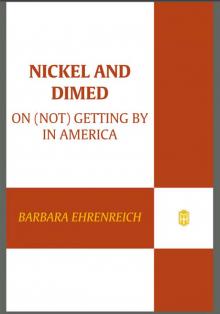 Nickel and Dimed: On (Not) Getting by in America
Nickel and Dimed: On (Not) Getting by in America Living With a Wild God
Living With a Wild God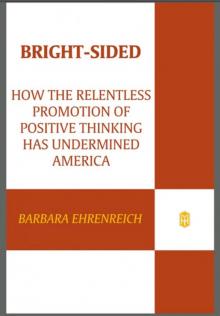 Bright-Sided
Bright-Sided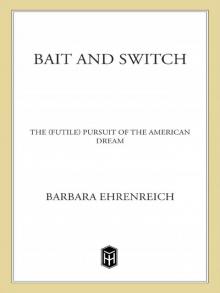 Bait and Switch: The (Futile) Pursuit of the American Dream
Bait and Switch: The (Futile) Pursuit of the American Dream Dancing in the Streets: A History of Collective Joy
Dancing in the Streets: A History of Collective Joy Had I Known
Had I Known Witches, Midwives, and Nurses
Witches, Midwives, and Nurses For Her Own Good: Two Centuries of the Experts Advice to Women
For Her Own Good: Two Centuries of the Experts Advice to Women Nickel and Dimed
Nickel and Dimed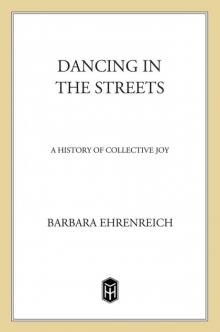 Dancing in the Streets
Dancing in the Streets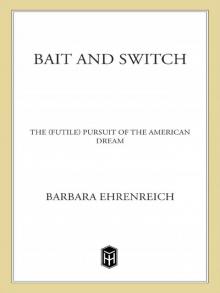 Bait and Switch
Bait and Switch